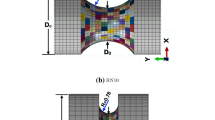Abstract
Compressive loading is often encountered in mining and mineral processes during the comminution of ore bearing minerals, or alternatively, in the wear-resistant materials used in the comminution circuit. A common thread joining many of the engineered materials used predominantly under compressive loading is the presence of a high modulus secondary phase, either fiber or particulate, embedded within a lower modulus matrix phase (i.e., a brittle heterogeneous material). To improve their toughness, an imperfect or a less-than-coherent interface is often strived for in the manufacture of many heterogeneous materials. To better understand the complex behavior of these materials, a model heterogeneous material system was developed by the U.S. Bureau of Mines and the Idaho National Engineering Laboratory. In this work, moiré interferometry was used to map the micromechanical displacements on the surface of the model system. Uniaxial and biaxial compressive loading was applied to a model system consisting of a PMMA (polymethylmethacrylate) plate having a precision ground steel rod as the cylindrical reinforcement. Moiré patterns revealed that two dominant phenomena occur along the interface: (1) frictional slip/stick and (2) a form of semi-cohesive bonding or mechanical locking. These observations were subsequently confirmed by nonlinear finite-element simulations of the model heterogeneous system. Experimental and numerical results show that the imperfect interface plays an important role in the micromechanical behavior of these model systems.
Similar content being viewed by others
References
Sammis, C.G. andAshby, M.E., “The Failure of Brittle Porous Solids under Compressive Stress States,”Acta Metall.,34,511–526 (1986).
Isida, M. andNemat-Nasser, S., “On Mechanics of Crack Growth and its Effects on the Overall Response of Brittle Porous Solids,”Acta Metall.,35,2887–2898 (1987).
Lajtai, E.Z., Carter, B.J. andAyari, M.L., “Criteria for Brittle Fracture in Compression,”Eng. Fract. Mech.,37,59–74 (1990).
Lajtai, E.Z., Carter, B.J. andDuncan, E.J.S., “Mapping the State of Fracture Around Cavities,”Eng. Geo.,31,277–289 (1991).
Lajtai, E.Z., Carter, B.J. andYuan, Y. “Tensile Fracture from Circular Cavities Loaded in Compression,”Int. J. Fract.,57,221–236 (1992).
Ashby, M.F. andHallam (née Cooksley), S.D., “The Failure of Brittle Solids Containing Small Cracks under Compressive Stress States,”Acta Metall.,34,497–510 (1986).
Horii, H. andNemat-Nasser, S., “Brittle Failure in Compression: Splitting, Faulting and Brittle-Ductile Transition,”Phil. Trans. Roy. Soc.,A319,337–374 (1986).
Ashby, M.F. andSammis, C.G., “The Damage Mechanics of Brittle Solids in Compression,”P. Appl. Geo. Phys.,133,489–521 (1990).
Madenci, E. andKlemm, W., “Compression-Induced Failure of a Glassy Material with a Crack-Like Defect,”Eng. Fract. Mech.,41,443–452 (1992).
Myer, L.R., Kemeny, J.M., Zheng, Z., Suarez, R., Ewy, R.T. andCook, N.G.W., “Extensile Cracking in Porous Rock under Differential Compressive Stress,”Appl. Mech. Reviews,45,263–280 (1992).
Sutcliffe, M.P.F. andFleck, N.A., “Effect of Geometry on Compressive Failure of Notched Composites,”Int. J. Fract.,59,115–132 (1993).
Vekinis, G., Ashby, M.F. andBeaumont, P.W.R., “The Compressive Failure of Alumina Containing Controlled Distributions of Flaws,”Acta. Metall.,39,2583–2588 (1991).
Barquins, M., Petit, J.P., Maugis, D. andGhalayini, K., “Path and Kinetics of Branching from Defects under Uniaxial and Biaxial Compressive Loading,”Int. J. Fract.,54,139–163 (1992).
Subhash, G. andNemat-Nasser, S., “Microcrack Induced Damage in Zirconia Ceramics under Uniaxial Compression: Experiments and Modeling,” Advances in Local Fracture/Damage Models for the Analysis of Engineering Problems, ed. J.H. Giovanoia and A.J. Rosakis, ASME-AMD,137,93–107 (1992).
Larbi, J.A., “Microstructure of the Interfacial Zone Around Aggregate Particles in Concrete,”Heron,38,1–69 (1993).
Monteiro, P.J.M., Maso, J.C. andOllivier, J.P., “Aggregate-Mortar Interface,”Cement and Concrete Res.,15,953–958 (1985).
Buyukozturk, O., Nilson, A.H. andSlate, F.O., “Deformation and Fracture of Particulate Composite,”J. Eng. Mech.,98,581–593 (1972).
Yamaguchi, E. andChen, W.F., “Post-Failure Behavior of Concrete Materials in Compression,”Eng. Fract. Mech.,37,1011–1023 (1990).
Yamaguchi, E. andChen, W.F., “Microcrack Propagation Study of Concrete under Compression,”J. Eng. Mech.,117,653–673 (1991).
Muskhelishvili, N.J., “Some Basic Problems of the Mathematical Theory of Elasticity,”3rd ed., Noordhoff Ltd, Holland (1953).
Ghahremani, F., “Effect of Grain Boundary Sliding on Anelasticity of Polycrystals,”Int. J. Solids Struct.,16,825–845 (1980).
Mura, T., “The Elastic Inclusion with a Sliding Interface,”J. Appl. Mech.,51,308–310 (1984).
Mura, T., Jasiuk, I. andTsuchida, B., “The Stress Field of a Sliding Inclusion,”Int. J. Solids Struct.,21,1165–1179 (1985).
Tsuchida, E., Mura, T. andDundurs, J., “The Elastic Field of an Elliptic Inclusion with a Slipping Interface,”J. Appl. Mech.,53,103–107 (1986).
Hashin, Z., “The Spherical Inclusion with Imperfect Interface,”J. Appl. Mech.,58,444–449 (1991).
Laird II, G. andKennedy, T.C., “Micromechanics of Imperfect Interfaces in Heterogeneous Materials,”Composites,25,593–603 (1994).
Joh, D., “An Experimental Study of Frictional Phenomena Around the Pin Joints of Plates using Moiré Interferometry,” PhD Diss., Dept. Eng. Sci. Mech., Virginia Polytechnic Inst. and State Univ. (1986).
Post, D., “Moiré Interferometry, in Handbook on Experimental Mechanics,”ed. A.S. Kobayashi, Prentice Hall, Englewood Cliffs, NJ 314–387 (1987).
Archard, J.F., “Elastic Deformation and the Laws of Friction,”Proc. Roy. Soc.,A243,190–205 (1957).
Scholz, C.H., “The Mechanics of Earthquakes and Faulting,”Cambridge Univ. Press, U.K. (1990).
Kragelskii, I.V., “Friction and Wear,”Butterworths, London, U.K. (1965).
Heyliger, R.R., “Frictional Phenomena in Planar Elastic Contact Stress Problems,” PhD Diss., Dept. Eng. Sci. Mech., Virginia Polytechnic Inst. and State Univ. (1986).
Morton, J., Post, D., Han, B. andTsai, M.Y., “A Localized Hybrid Method of Stress Analysis: A Combination of Moiré Interferometry and FEM,”Experimental Mechanics,30,195–200 (1990).
Leonard, D., Dupont Polymers, Memphis, TN (1993).
McCrum, N.G., Buckley, C.P. andBucknall, C.B., “Principles of Polymer Engineering,”Oxford Univ. Press, NY (1988).
Barquins, M. andPetit, J.P., “Kinetic Instabilities During the Propagation of a Branch Crack: Effects of Loading Conditions and Internal Pressure,”J. Struct. Geo.,14,893–903 (1992).
Nemat-Nasser, S. andHori, H., “Compression-Induced Nonplaner Crack Extension with Application to Splitting, Exfoliation, and Rockburst,”J. Geophysical Res.,87,6805–6821 (1982).
Hori, H. andNemat-Nasser, S., “Compression-Induced Microcrack Growth in Brittle Solids: Axial Splitting and Shear Failure,”J. Geophysical Res.,90,3105–3125 (1985).
Jaeger, J.C. andCook, N.G.W., “Fundamentals of Rock Mechanics,”3rd Ed, Chapman and Hall, London (1979).
Epstein, J.S., “Moiré Interferometry in Materials Behavior Research,”Microstructural Science,14,ed. M.R. Louthan,Jr.,I. LeMay, andG.F. Vander-Voort,ASM Int. Pub.,Metals Park, OH,575–593 (1985).
ANSYS User's Manual,IV,Theory,ed. P. Kohnke,Swanson Analysis Systems,Houston, PA (1992).
ASM Handbook,18:Friction, Lubrication, and Wear Technology, Amer. Soc. of Metals Int., 73 (1992).
Author information
Authors and Affiliations
Rights and permissions
About this article
Cite this article
Laird, G., Epstein, J.S. & Kennedy, T.C. Micromechanics of a model heterogeneous material system under compressive loading. Experimental Mechanics 35, 293–305 (1995). https://doi.org/10.1007/BF02317538
Received:
Accepted:
Issue Date:
DOI: https://doi.org/10.1007/BF02317538




